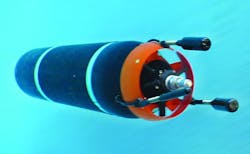Unmanned marine vehicle companies to build 29,550 systems worth $15.4 billion in next decade
This study includes torpedoes, military unmanned surface vehicles (USVs), and unmanned underwater vehicles (UUVs).
The torpedo segment will be worth $8.1 billion over the next 10 years, with the USV and UUV segments worth $6.1 billion and $1.2 billion, respectively, Forecast International analysts say.
"Sales of torpedoes will account for more than half of this market's value, but the unmanned vehicle segments are growing rapidly," says Larry Dickerson, Forecast International's senior unmanned systems analyst. USVs and UUVs may be used as naval targets, or to perform offshore patrol duties and mine clearing.
Overall production will rise from 2,722 units in 2015 to a decade-high of 3,243 units in 2018, before descending to a low of 2,340 in 2022, analysts say.
Given the increasingly high costs for these systems, the value of production will rise from $1 billion in 2015 to a high of $2.1 billion in 2024.
Different companies lead in each segment, with some firms competing in more than one. Leading torpedo manufacturers, in terms of 10-year value of production, include Raytheon (Mk 54 LHT), Atlas Elektronik (DM2A4), Roketsan (Akya), and Mitsubishi Heavy Industries (Type 12).
Atlas Elektronik is also making headway within the expendable mine disposal vehicle (MDV) segment. Its Seafox is the most successful MDV currently on the market, although BAE Systems is aiming to win a greater share with its Archerfish.
General Dynamics is competing for a share of the remotely operated vehicle segment with its new Knifefish UUV. Such systems are reusable and the primary means of clearing naval mines until the arrival of the new expendable MDVs. ECA has a long history of success with its PAP series. The company has manufactured more than 500 systems and exported them to customers worldwide.
For decades, navies used unmanned surface vessels as surface targets during naval exercises and weapons systems testing. Some of these seaborne target systems are very sophisticated, analysts say. One example is the former U.S. Navy Spruance class USS Paul F. Foster (DD 964), now the EDD-964 Foster Self-Defense Test Ship (SDTS).
In addition to testing self-defense systems, unmanned surface vessels are assuming other responsibilities. For example, Israel uses USVs to patrol its maritime border with the Gaza Strip, while the U.S. Navy will use USVs to work with the Littoral Combat Ship (LCS).
A growing number of European nations also are experimenting with USVs. France, Germany, Italy and Turkey could deploy new USVs over the next 10 years.
For more information contact Forecast International online at www.forecastinternational.com.
